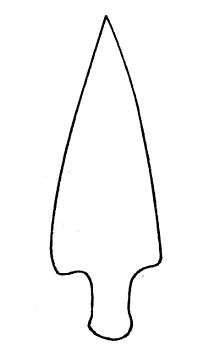Paiján culture
The Paiján culture was an archaeological culture that developed on the northern coast of Peru between 8,700 and 5,900 BCE.[1] It was first described by Peruvian archaeologist Rafael Larco Hoyle in the 1940s from the Pampa de los Fósiles site.[2] Later research, mainly by French archaeologist Claude Chauchat, identified dozens of open air sites, which include camps, workshops and quarries.[3]

Generally, this culture would belong to the Lithic stage of cultural development.
Geography
Most findings are concentrated along the valleys of the rivers Jequetepeque, Cupisnique, Chicama and Moche in the northern coast of Peru; more limited evidences of Paiján presence have been found in the central and south coasts of Peru as well as in the highland site of El Inga in Ecuador.[4]
Environment
The Paiján environment was arid with sparse vegetation and small animals such as rodents, lizards and snails; further resources were provided by the sea which at the time was located 15 kilometers farther than today due to a .lower sea level.[5] To adapt to this environment, the Paiján developed long needle–like projectile points which were mounted on hollow shafts of cane or reed and be used as harpoons to catch fish; they also collected snails, hunted small animals such as vizcachas and used grinding stones to process plants.[6]
Paijan projectile points
Paijan stemmed points are separated into several classes when being classified as they are found on sites. These classes include: lanceolate, triangular, intermediate, and miscellaneous.
- Lanceolate: have convex-sided bodies with a “maximum width that is different from the base; the tip is very long, thin and sharp”.[7]
- Triangular: have “straight sides with a maximum width that is located at the base of the body”.[8]
- Intermediate: have a “maximum width that may be at the base of the convex-sided body or convexity may be so poor that attribution is dubious”.[9]
- Miscellaneous: have stemmed points that do not fall within the other three classes”.[10]
Common tools
Common Paijan tools used included single and double sidescrapers, unifaces – pieces or tabular blocks retouched on one face only all around the edge to give them an ovate shape, borers – rare small jasper blocks that have 3 points, and most abundantly - denticulates which have thick, steep edges. Bifaces are another common artifact found on Paiján sites.[11]
Time period
Early Paiján sites, dated between 8,600 and 8,000 BCE, indicate large bands that moved seasonally between the coastal plains and the western slopes of the Andes; later sites, dated between 8,000 and 6,500 BCE, evidence smaller groups of decreased mobility.[12] According to anthropologist Tom Dillehay, a possible explanation for this change is that an amelioration of the climate increased the availability of wild plants and animals; thus, Paiján people required less movement to meet their requirements while still relying on hunting-gathering.[13]
Oldest human remains
In 1975, at La Pampa de los Fósiles, Claude Chauchat discovered skeletal remains of a teenager about 12-13 years old, and of a young woman of about 25 years old, buried in a layer of ash. Radiocarbon studies gave an age of 10,200 ± 180 before present. They are therefore considered as the oldest human remains in Peru.
See also
Notes
- Tom Dillehay et al, "The first settlers", p. 21.
- Tom Dillehay, The Settlement of the Americas, p. 145.
- Danièle Lavallée, The first South Americans, pp. 97–98.
- Tom Dillehay, The Settlement of the Americas, pp. 145–146.
- Danièle Lavallée, The first South Americans, p. 98.
- Michael Moseley, The Incas and their ancestors, pp. 93–94.
- “The Paijan Complex, Pampa De Cupisnique, Peru”, Claude Chauchat in Ñawpa Pacha: Journal of Andean Archaeology, 13, 1975
- “The Paijan Complex, Pampa De Cupisnique, Peru”
- “The Paijan Complex, Pampa De Cupisnique, Peru”
- “The Paijan Complex, Pampa De Cupisnique, Peru”
- “The Paijan Complex, Pampa De Cupisnique, Peru”
- Tom Dillehay et al, "The first settlers", pp. 21–22.
- Tom Dillehay, "Profiles in Holocene History", p. 38.
References
- Dillehay, Tom. "Profiles in Holocene History". In Helaine Silverman and William H. Isbell (eds.), Handbook of South American archaeology. New York: Springer, 2008, pp. 29–43.
- Dillehay, Tom. The Settlement of the Americas: a new prehistory. New York: Basic Books, 2000.
- Dillehay, Tom, Duccio Bonavia and Peter Kaulicke. "The first settlers". In Helaine Silverman (ed.), Andean archaeology. Malden, MA: Blackwell, 2004, pp. 16–34.
- Lavallée, Danièle. The first South Americans: the peopling of a continent from the earliest evidence to high culture. Salt Lake City: University of Utah Press, 2000.
- Moseley, Michael. The Incas and their ancestors: the archaeology of Peru. London: Thames and Hudson, 2004.